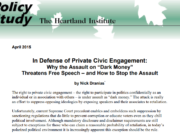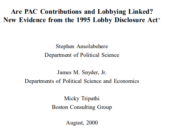In this article, Jay Goodliffe provides a model of campaign spending and savings in consecutive elections that allows for statistical analysis of the reasons underlying the creation of war chests. Substantiated by significant empirical evidence, the model predicts that incumbents create war chests in preparation for future elections when faced with a weaker challenger. Given Goodliffe’s previous research into war chests, this article proves that war chests do not deter candidates from running in elections against incumbents. Instead, he argues that incumbents establish war chests after procuring savings from an uneventful election, in order to save for future election campaigns. Ultimately, Goodliffe concludes that, “campaign finance reforms that eliminate war chests may not encourage prospective challengers, but it may cause vulnerable incumbents to lose more often.” This is quite tangential to the typical perception of many in the campaign finance community and is likely a better and more nuanced explanation of the consequences of campaign war chests.
For further reading on this issue in other studies by Jay Goodliffe, see:
- “Campaign Fund-raising and Spending for Deterrence and Savings” (2009)
- “Campaign War Chests and Challenger Quality in Senate Elections” (2007)
- “When do War Chests Deter?” (2005)
- “The Effect of War Chests on Challenger Entry in U.S. House Elections” (2001)
- “Campaign Finance in U.S. House Primary and General Elections” (2001)














